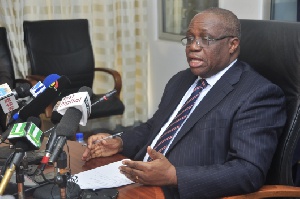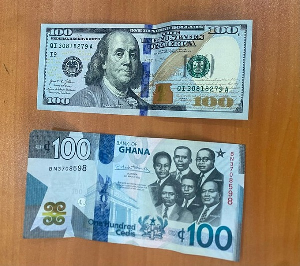The Bank of Ghana on Monday announced an increase in the policy rate from 25 to 26 per cent following its 67th Monetary Policy Committee (MPC) meeting held on Friday, November 13.
Monetary policy is the process by which the central bank of a country controls the supply of money, often targeting an inflation rate or interest rate to ensure price stability and general trust in the currency.
Speaking at a media briefing in Accra, Dr Henry Kofi Wampah, Governor of the Central Bank, said the latest release by the Ghana Statistical Service puts inflation at 17.4 per cent in October, same as in September and up from 17.3 per cent in August.
He said this indicates some moderation in price movements over the past three months, supported by tight monetary policy stance, the appreciation of the exchange rate in July as well as falling international crude oil prices.
The Governor said this notwithstanding, the current level of inflation and the latest inflation expectations remain far above the medium term target band of 8±2 per cent.
He said the core inflation (Consumer Price Index (CPI) inflation excluding energy and utility prices), which typifies underlying inflation, has also continued to rise over the period.
“Also, there are imminent upside risks to the inflation outlook such as worsening external financial conditions and the planned utility tariff adjustments which are now likely to be higher than anticipated during the last MPC,” he said.
Dr Wampah said on a year-to-date basis, the Ghana cedi depreciated by 15.5 per cent as at October 2015, compared with 31.2 per cent in the corresponding period of 2014.
“Going forward, maintaining a tight monetary policy stance will reinforce the relative stability in the foreign exchange market and dampen risks related to the external financial conditions,” he said.
Dr Wampah said assessments of current economic conditions show that though monetary policy remains tight, some additional tightening is required to re-anchor the displaced inflation expectations.
He said this, together with the on-going fiscal consolidation, is expected to break the high inflation inertia.
He said their current forecasts show that without any additional policy adjustment, inflation is likely to drift farther away from the target band and lengthen the forecast horizon into late 2017.
“The Bank’s Real Composite Index of Economic Activity (CIEA) for September 2015 indicates a slower pace of growth compared with the same period in 2014.
“However, in the medium term, growth conditions are expected to recover, supported by a turnaround in the energy situation, increased production of oil and gas and a general improvement in the macroeconomic environment as inflation starts trending down,” he said.
Dr Wampah said the fiscal consolidation remains on track.
He said for the first nine months of the year, the overall budget balance registered a cash deficit of 5.1 per cent of gross domestic product (GDP) which is within the programme target of 5.7 per cent.
He said maintaining the fiscal consolidation efforts would complement the tight monetary policy stance for the attainment of the medium term inflation target.
Dr Wampah said this would, in turn, help create conditions for long term sustainable growth.
He said: “Risks from the global environment have heightened, driven mainly by slower growth prospects in China and other emerging market economies.
“Also, commodity prices continue to decline amidst tightening financial conditions. These have resulted in increased depreciation of currencies ranging from 19 per cent to about 48 per cent year-to-date in most commodity exporting countries.”
Dr Wampah said the transmission of these risks presents clear threats to the balance of payments outlook.
“For the first 10 months of 2015, the overall balance of payments position, as measured by the change in net international reserves, worsened to a deficit of $ 378 million, compared with a surplus of $ 181.6 million for the corresponding period of 2014,” the Governor said.
“At the end of October 2015, gross foreign assets stood at $ 5.7 billion (3.4 months of imports),” he added.
He said the current account balance for the first nine months recorded a deficit equivalent to 5.4 per cent of GDP.
The Governor said the Committee noted that overall, the risks to the inflation outlook were on the upside, with a likelihood of a further drift away from the medium term target, hence its decision on the monetary policy rate.
He said the Committee would continue to monitor developments in the economy and take appropriate action if necessary, including the possibility of lowering the policy rate once inflation expectations are well-anchored.
The next Monetary Policy Committee (MPC) meeting is scheduled for Friday January 22, 2016.
The meeting will conclude on Monday January 25, 2016 with an announcement of the policy decision.
Business News of Wednesday, 18 November 2015
Source: GNA













